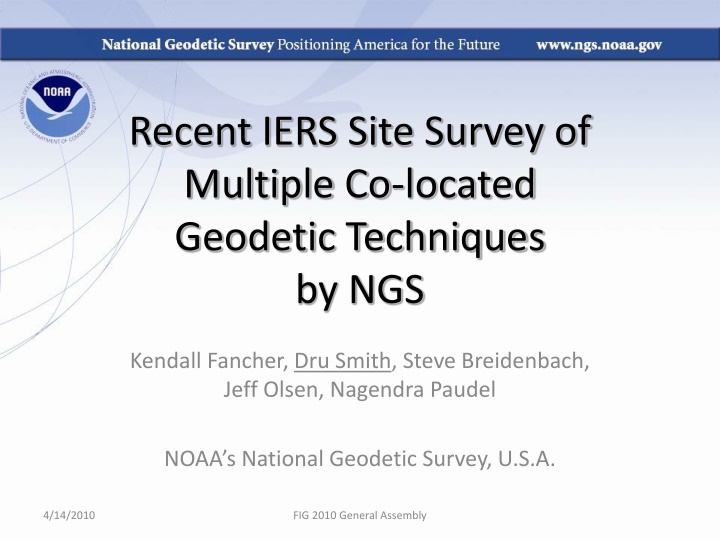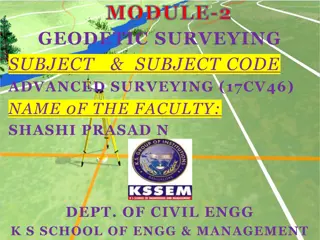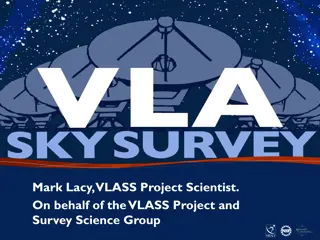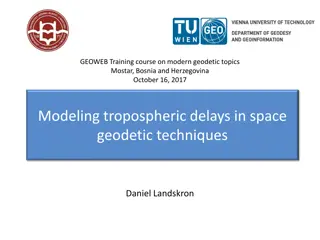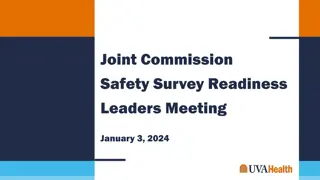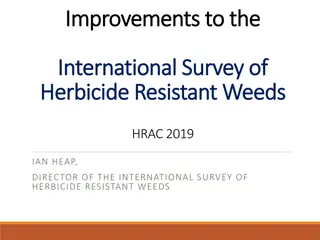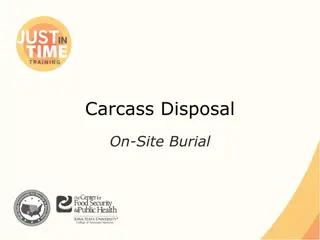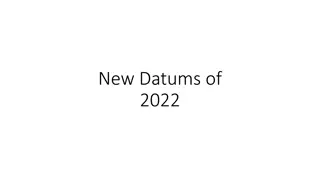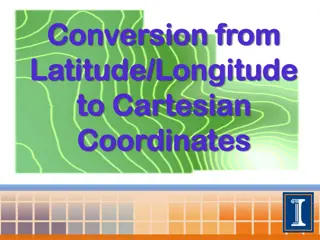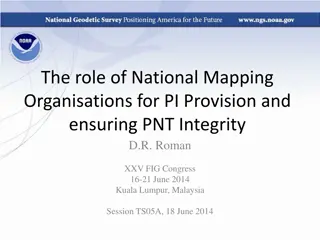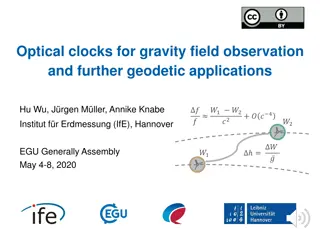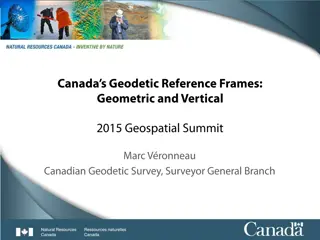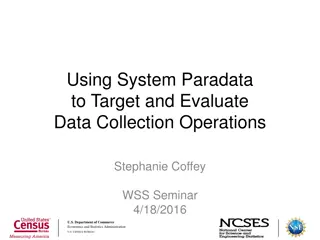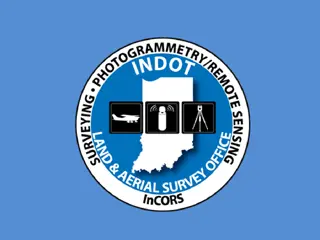Recent IERS Site Survey of Co-located Geodetic Techniques
In this presentation, the focus is on the relationship between national datums and the International Terrestrial Reference Frame (ITRF). It discusses the need for co-location site surveys and the reliance on the International Earth Rotation and Reference Systems Service (IERS) by national geodetic authorities. The importance of resources and reliance on ITRF for its improvement and maintenance is highlighted, along with examples of co-location techniques such as VLBI, SLR, GNSS, and DORIS. The significance of ground co-location surveys and the difference between Electronic Reference Point (ERP) and Physical Reference Point (PRP) are also explained.
Download Presentation

Please find below an Image/Link to download the presentation.
The content on the website is provided AS IS for your information and personal use only. It may not be sold, licensed, or shared on other websites without obtaining consent from the author.If you encounter any issues during the download, it is possible that the publisher has removed the file from their server.
You are allowed to download the files provided on this website for personal or commercial use, subject to the condition that they are used lawfully. All files are the property of their respective owners.
The content on the website is provided AS IS for your information and personal use only. It may not be sold, licensed, or shared on other websites without obtaining consent from the author.
E N D
Presentation Transcript
Recent IERS Site Survey of Multiple Co-located Geodetic Techniques by NGS Kendall Fancher, Dru Smith, Steve Breidenbach, Jeff Olsen, Nagendra Paudel NOAA s National Geodetic Survey, U.S.A. 4/14/2010 FIG 2010 General Assembly
Outline Relation between national datums and ITRF Need for co-location site surveys GGAO survey by NGS Future activities 4/14/2010 FIG 2010 General Assembly
National datums and the ITRF 2-D Horizontal datum? 3-D Geometric Reference System! Many countries adopt a frame tied to ITRF USA: 14 parameter Helmert Transform. NAD 83 (CORS96) ITRF 96 4/14/2010 FIG 2010 General Assembly
Reliance on IERS National Geodetic Authorities: Define national reference systems (datums) Have resources Rely on IERS to provide the ITRF IERS Updates the ITRF Is a voluntary international organization 4/14/2010 FIG 2010 General Assembly
Resources vs. Reliance My recent pitch to NGS policy makers: It is the duty of those agencies with both resources and a reliance on ITRF to apply some of those resources to the improvement and maintenance of the ITRF Currently in NGS policy debate for 2010 4/14/2010 FIG 2010 General Assembly
Co-location Site Surveys ITRF realizations are the combination of four space geodetic techniques VLBI, SLR, GNSS, DORIS Each contributes differently to ITRF Co-locating these techniques allows for their combination. Examples of co-location: Space (SLR reflectors on GNSS satellites) Ground (GNSS antennas near VLBI antennas) 4/14/2010 FIG 2010 General Assembly
Ground co-location Antennas near one another is not enough Must know 3-D geometric vector from ERP to ERP* * Electronic Reference Point Co-location surveys only yield PRP to PRP* *Physical Reference Point 4/14/2010 FIG 2010 General Assembly
ERP ( ) vs PRP ( ) ERP for VLBI Offset vector responsibility: IVS ERP for GPS (e.g. L1 Phase Center) PRP for VLBI Offset vector responsibility: IGS PRP for GPS (e.g. ARP) Note: PRP need not be touchable , just geometrically determinable (e.g. VLBI = intersection of two orthogonal spin axes) 4/14/2010 FIG 2010 General Assembly
GGAO Survey Anticipating a policy shift, NGS engaged in re- training employees in co-location survey techniques Goddard Geophysical and Astronomical Observatory, Maryland, U.S.A. PRP-to-PRP only 4/14/2010 FIG 2010 General Assembly
GGAO 4/14/2010 FIG 2010 General Assembly
GGAO 4/14/2010 FIG 2010 General Assembly
GGAO Control Network 4/14/2010 FIG 2010 General Assembly
GGAO Survey Equipment GPS Trimble R7 GNSS receivers Javad Ringant-DM GNSS antenna Leveling Leica DNA03 digital level 2-meter Invar staff Angles and Distances Leica TDMA 5005 total station Leica GPH1P precision reflectors 4/14/2010 FIG 2010 General Assembly
Status of GGAO Project GPS data analysis completed Tie vector data analysis is near completion A project report will be delivered to the IERS in the format proposed by the IERS Site Survey and Co-location Working Group 4/14/2010 FIG 2010 General Assembly
NGS Future Work Planning other IERS site surveys Brewster (Washington State, USA, VLBI/GNSS) planned for 2010 Debating total resource allocation for future years Engaged in IERS Site Survey and Co-location Working Group 4/14/2010 FIG 2010 General Assembly
NGS Future Work Evaluating external software (Sarti , Johnston) for future operational use Training additional employees on site survey techniques 4/14/2010 FIG 2010 General Assembly
FIG Future Work Efficiency is gained if the IERS has site surveys performed by local persons at local sites Think globally, act locally NGS will likely work with other international agencies to develop training and workshops to encourage more international participation on IERS site surveys we all benefit! 4/14/2010 FIG 2010 General Assembly
Questions? 4/14/2010 FIG 2010 General Assembly
